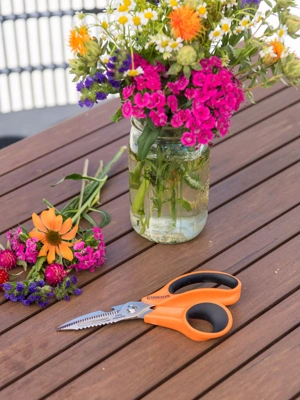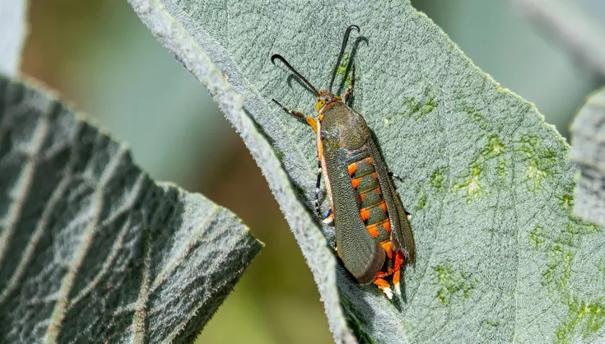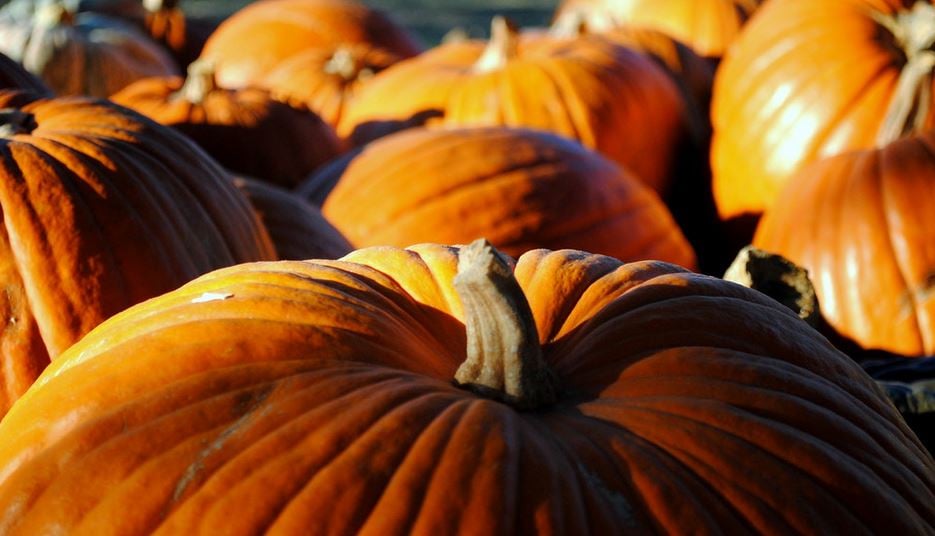Get Cooking with Pumpkin
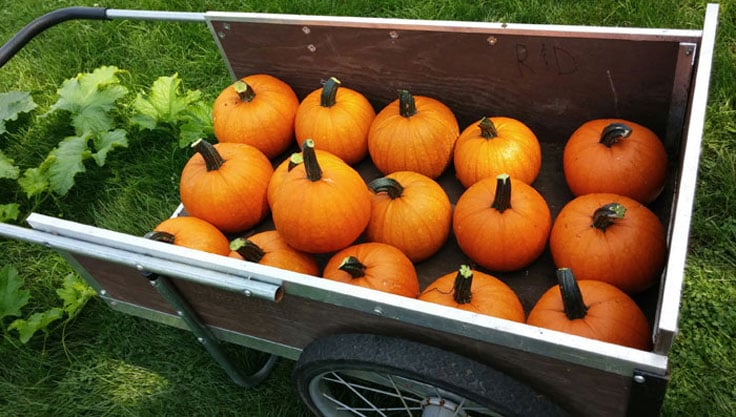 This cartload of pie pumpkins was harvested from a single plant, which produced 29 pumpkins.
This cartload of pie pumpkins was harvested from a single plant, which produced 29 pumpkins.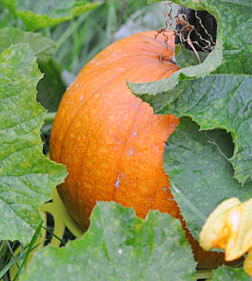
 Black Futsu, an unusual Japanese variety, takes on a powdery look when ripe.
Black Futsu, an unusual Japanese variety, takes on a powdery look when ripe. Kakai is a variety with hull-less seeds.
Kakai is a variety with hull-less seeds.The magnificent pumpkin is perhaps the most iconographic reminder that a new season is upon us. Put a pumpkin on your front porch and you're ready to celebrate the season. But what about bringing pumpkins from the porch into the kitchen?
The orange flesh of pumpkins is sweet enough for pie, cake or muffins, yet savory enough for soup or soufflé hollowed-out shell can be used as a serving vessel. Even the seeds make a healthy snack. Yet, pumpkins are not likely to be on your grocery list, unless you are shopping for Halloween. And when it comes to pumpkin pie, many canned commercial brands actually contain winter squash — such as butternut — because it tends to be less stringy and more flavorful. A typical Halloween pumpkin can be watery and bland-tasting.
For a delicious pumpkin pie, it's essential to grow (or buy) a pie pumpkin, otherwise known as a sugar pumpkin. These small orange orbs weigh an average of 4 pounds. Once they are peeled, quartered and baked for an hour to soften, they yield about two cups of puree, just enough for a pie — or something else.
Pumpkins are part of the cucurbit family, yet the term pumpkin is generic for "large, hard-skinned squash," which includes butternut, Cushaw, Hubbard and Red Kuri. This family has many cousins, including a host of ornamental pumpkins, such as mini pumpkins — which are more of a gourd — and jumbo pumpkins, which require a special diet to pump up the flesh.
Take a walk back in time, when most of the pumpkins and the winter squash were derived from an American heirloom, the cheese pumpkin. In the early 1800s, settlers from Europe grew the pumpkin, which was so-named because of its resemblance to a wheel of aged cheese: creamy tan on the outside with a distinctive lobed top.
An early recipe book describes the practice of making a "cheese." The pumpkins were cooked down to a thick paste — often with watermelon juice. The result was a dark brown, slightly sweet substance, similar to apple butter.
Pumpkins and winter squash are grown universally, yet many are regional in nature. In some parts of the world, pumpkins are a staple: Latin American cooks use them in casseroles, Indians make curry, while Italians fill tiny ravioli and serve them with crisp sage leaves as garnish. Get to know these generous vegetables as more than Halloween decorations, and you will be eating very well indeed.
Homemade puree: King Arthur Flour has an excellent blog post on making your own pumpkin puree.
Pumpkin Crème Caramel
Makes 6 servings
Add pumpkin puree to the classic custard with caramel sauce, and you'll get a dessert with a rich, dark color and autumnal flavor.
- 3/4 cup sugar
- 1 cup half-and-half
- 1 cup milk
- 1 vanilla bean or 1 teaspoon vanilla extract
- 6 large eggs
- 1/3 cup sugar plus 1 tablespoon sugar
- 1/4 teaspoon ground cinnamon
- 1/4 teaspoon grated nutmeg
- 2/3 cup pumpkin puree (homemade or canned)
Preheat oven to 300 degrees F.
To make the caramel, you will need six 4-ounce ramekins or custard cups.
In a medium saucepan, combine 1/4 cup water and the sugar. Bring to a boil over high heat, stirring just until the sugar dissolves. Cook without stirring, swirling the saucepan by the handle occasionally, until the syrup has turned golden brown, about 5 minutes. Immediately pour equal amounts of the hot caramel into the ramekins.
In a medium saucepan, heat the half-and-half, milk and the vanilla bean over medium heat, until tiny bubbles form around the edges of the liquid. Remove the vanilla bean and scrape the seeds back into the milk with a sharp knife. If you are using vanilla extract instead, add it now.
In a separate bowl, whisk together the eggs, sugar, cinnamon and nutmeg until combined, then whisk in the pumpkin puree. Gradually whisk in the hot milk mixture. Using a strainer, pour equal amounts of the liquid into the ramekins.
Place the ramekins in a large roasting pan. Add hot water to come halfway up the sides of the ramekins. Bake until a knife inserted into the center of the custard comes out clean, about 1 hour. Remove the ramekins from the water and cool completely. When ready to serve, run a table knife around the inside of each ramekin, and invert onto a dessert plate. Top with toasted coconut (optional).
Pumpkin Ravioli
Makes 24 to 30 ravioli
Wonton wrappers are a quick, easy substitute for fresh pasta. Serve with butter and grated parmesan cheese.
- 1 cup pumpkin puree (homemade or canned)
- 1 cup ricotta cheese
- 1 1-inch knob of fresh ginger root, finely grated
- 1/2 cup pecans, light toasted and finely chopped
- 1/2 teaspoon fine sea salt
- 1/4 teaspoon freshly ground pepper
- 1/4 cup fresh flat-leaf parsley, finely chopped
- 1 package wonton wrappers
In a small bowl, combine pumpkin puree, ricotta cheese, fresh ginger and pecans. Stir in the salt, pepper and parsley.
Remove six wonton wrappers and set them on a table or work surface. Spoon one teaspoon of filling into the center of each wonton skin. Fill a small cup with water and, with your finger or a small pastry brush, moisten the edge of each wrapper with water. Remove another six wrappers and place on top of the filling, lightly pressing all the air out from around the filling. Press the edges together so they are firmly closed, crimp with a pastry cutter (optional) or trim with a knife to even out the sides. Place on a wire rack until ready to cook.
To cook: Fill a large sauté or wok with enough water to cover the wontons. Bring to a boil, lightly salt. Add the wontons in a single layer and simmer until the wrappers become translucent; transfer to a colander to drain. Serve lightly tossed with butter, Parmesan cheese and additional chopped parsley.
Pumpkin Seeds
Just as there are different types of pumpkins, there are also different types of seed. In a traditional Jack-o-Lantern you will find thick, white seeds that are usually slow-roasted and salted. They taste OK, but there are better options.
For instance, consider hull-less pumpkin seeds, which come from winter (long season) cucurbits. These seeds are more digestible because they lack a tough outer hull. They are also known as oil-seed pumpkins or Styrian pumpkins. Look for Lady Godiva and Kakai hull-less pumpkins.
Roasted Pumpkin Seeds
Preheat oven 250 degrees F.
Separate seeds from the pumpkin pulp, soak in salted water for a few hours or overnight. Drain and pat dry. For every 2 cups of seeds, use 2 tablespoons olive oil and 1 teaspoons salt. Combine and spread out on a cookie sheet. Bake for 1 hour, or until the seeds are lightly toasted and crunchy.
Last updated: 04/19/2023
Print this Article:
Related items
Related Articles
Get the Dirt
Stay up to date on new articles and advice. Please fill out the information below.



